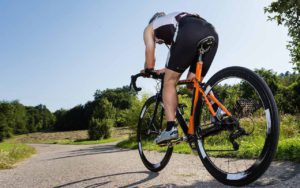 Whether you’re young or old, athletic or sedentary, bicycling is an enjoyable and healthy way to travel and experience the outdoors. Done vigorously, it gives the heart and circulatory system a workout and can burn more than 500 calories per hour. The development of new types of bicycles—notably the hybrid, which combines the speed of a road bike and the ruggedness of a mountain bike—has made riding easier and offers more options to suit your specific needs. What’s more, cyclists now have more places to ride. Here, ways to improve your performance, safety and comfort when cycling.
Whether you’re young or old, athletic or sedentary, bicycling is an enjoyable and healthy way to travel and experience the outdoors. Done vigorously, it gives the heart and circulatory system a workout and can burn more than 500 calories per hour. The development of new types of bicycles—notably the hybrid, which combines the speed of a road bike and the ruggedness of a mountain bike—has made riding easier and offers more options to suit your specific needs. What’s more, cyclists now have more places to ride. Here, ways to improve your performance, safety and comfort when cycling.
1 – Wear a Helmet
More than 6,000 cyclists seek emergency care for head injuries each year in the U.S., and head trauma accounts for 75 percent of cycling fatalities. Used properly, bike helmets are nearly 90 percent effective in preventing brain injuries. Choose a helmet that meets the standards of the U.S. Consumer Product Safety Commission. Or, look for a sticker from the Snell Memorial Foundation or the American Society of Testing and Materials. Pick a bright color and a helmet that fits snugly.
2 – Make Sure It Fits Your Frame
Buying a new bike? To find the right frame size for your body, straddle the bike and stand flat-footed. On a road bike, there should be one to two inches of clearance between your groin and the top tube. On a mountain bike, the clearance should be at least two inches.Your handlebars should be one inch lower than your seat top. Buy your bicycle from a reputable dealer who will help you find the right bike and fit.
3 – Pick the Right Seat
The hard, narrow seats on racing bikes can be particularly uncomfortable for women, who tend to have widely spaced “sit bones.” Special anatomically designed saddles—wider and more cushioned at the back—are easy to install. Gel-filled saddles or pads or sheepskin pads can ease pressure and friction. Position the saddle so that your knee is only slightly bent at the bottom of each rotation. If it’s bent too much, the seat is too low; if the knee locks when extended, or you have to reach for the pedal, the seat is too high. Adjust the seat’s “fore-aft” position and make sure the seat is level (or that the nose is just slightly higher).
4 – Start Slowly
If you are out of shape, it’s best to start slowly. Pedal just 30 minutes or so a day on flat terrain for the first three or four weeks. Gradually, you can increase the intensity of your riding and your choice of terrain, adding hills for a better workout. Also, share the fun with others. Riding in a group can make the miles zip by faster and motivate you to become a better cyclist.
5 – Dress for Comfort
If you cycle a lot, consider wearing a pair of sleek cycling shorts. They have less fabric to wrinkle or bunch up, so there’s less chance of skin irritation. For extra protection, choose cycling shorts with no seams at the crotch and special lining or padding to wick away perspiration. If you use clipless pedals, you’ll need to wear special cycling shoes with a cleat fitted to the sole; they lock into a mechanism in the pedals, holding the shoes in place. These can be a little hard to get used to, but help you pedal more powerfully and efficiently.
6 – Go Bright When in Low Light
Avoid riding at night. Most cycling deaths occur between 6 pm and 9 pm. If you expect to cycle in low-light conditions, wear brightly colored, reflective clothing, and put reflective tape on your helmet and bike (actually, these are smart strategies any time of day). Also, install a strong headlight and a strobe-type, blinking red tail light. You can attach the strobe light to your bike or your belt to make it easier for others to see you at night or when the light is low.
7 – Always Use Good Road Sense
Ride with traffic, give right of way to cars and pedestrians, use hand signals and obey all signs. Communicate with drivers. That means using hand signals when you turn, staying out of drivers’ blind spots and making eye contact with drivers as you pull into an intersection or make a turn, so they know your intentions and you know that they’ve seen you. Don’t ride side by side with another cyclist. Keep an eye out for car doors swinging open, potholes and other potential hazards.
8 – Be Traffic-Savvy
If you’re cycling in heavy traffic, on a narrow road or on winding downhill roads, ride in the lane with the cars, not to the side, where you’re not as visible and may get pushed off to the side. Of course, if a car wants to pass, move out of the way. Whether you think you’ll be riding in heavy traffic or light, it’s wise to attach a bicycle rear-view mirror to your handlebar, helmet or eyeglasses.
9 – Do Your Best Braking
To exert optimal pressure, brake with your hands at the ends of the levers. For a quick stop, press your bicycle’s brakes firmly and slide your buttocks to the very back of the saddle. This will keep the rear of the bike down so that you don’t flip over the handlebars. When you are on long downhills and in wet weather, try to “feather brake” by tapping the brakes and applying intermittent pressure. In general, don’t squeeze your brakes too hard, and don’t squeeze the front brake first. Instead, apply firm pulses to both brakes.
10 – Get In Gear
Don’t pedal in high gear for long periods; this can increase pressure on your knees. Shift to lower gears and faster revolutions to get more exercise with less stress on your knees. The best cadence for most cyclists is 60 to 80 revolutions per minute (rpm), though bicycle racers pedal in the range of 80 to 100 rpm.
11 – Help Your Muscles
After a long uphill on your bicyle, don’t coast downhill without pedaling. Here’s why: As you climb up the hill, lactic acid builds up in your muscles and can contribute to muscle soreness. By pedaling lightly but constantly while you are coasting downhill—even if there’s little resistance—you can help remove the lactic acid.
12 – Change Positions
Vary your hand and body position frequently. That changes the angle of your back, neck and arms, so that different muscles are stressed and pressure is put on different nerves. Avoid riding with your hands on the curved part of the handlebars for a long time. This may cramp your hands, shoulders and neck. Keep your arms relaxed and don’t lock your elbows. This will help you absorb bumps better.
